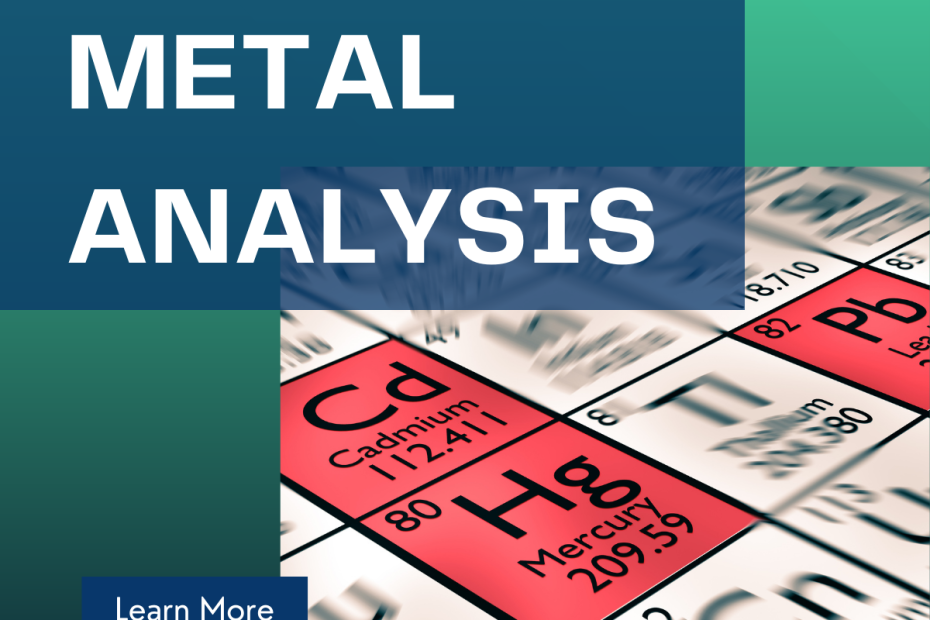Heavy metals are generally referred to as metals which possess a specific density of more than 5 g/cm3 and are harmful to the environment and living organisms.
They can have a weighty impact on the environment and human health, even at tiny concentrations, so their analysis is of real importance. Some are terribly persistent, so we actually wouldn’t like them to live very long in the environment at all!
Heavy metal exposure comes through residential and occupational routes, and there are twenty-three heavy metals which are of concern for human and environmental health. These include antimony, arsenic, bismuth, cadmium, cerium, chromium, cobalt, copper, gallium, gold, iron, lead, manganese, mercury, nickel, platinum, silver, tellurium, thallium, tin, uranium, vanadium, and zinc
Heavy Metals analysis typically includes five main elements due to them being of significant toxicological concern compared to the other elements. These five are Mercury, Lead, Chromium, Cadmium, and Arsenic. Slightly less common, but regularly analysed are Copper, Nickel and Zinc.
Analysis of these metals is required due to acute and chronic toxicity which can occur from very low concentrations levels. Mechanisms are debated for each individual element’s toxicity but there is a general conclusion that the toxicity of heavy metals is due to the fact they displace original metals from their natural binding sites, causing the cells to malfunction which eventually leads to toxicity.
Today we’ll focus on the main five elements in a bit more detail, but if you’re interested in any of the others, please get in touch!

Arsenic
Carcinogenic
Sources of exposure include natural (drinking water contamination from pesticides or natural mineral deposits) and industrial (timber treatment, agricultural chemicals, mining and burning fossil fuels). Arsenic is a carcinogen, which means that it has the ability to cause cancer in humans.
More studies are required to better understand the toxicity of different arsenic species, but the general consensus is that inorganic arsenic (iAs) is more toxic than organoarsenic compounds. Hence speciation analysis is required to determine if the toxic arsenic species are part of the total arsenic concentration. (Follow us to see more about speciation in the coming weeks!)
Lead
Highly persistent, no biological function
Sources of exposure of lead can come from industrial process (metal plating, factory chimneys) food and smoking, drinking water and domestic sources (petrol, house paint). Lead from exhausts and other activities is taken up by plants which then becomes the source to the general population through food or drinking water.
Some elements, such as chromium and selenium are essential at low concentrations for human health but become toxic at higher concentrations. Lead is an element which is non-essential at any concentration meaning it has no biological function.
Mercury
Exceptionally Bioaccumulative
Major sources of mercury pollution include anthropogenic activities such as discharges from municipal or industrial wastewater, mining, agriculture and incineration.
Mercury exists as a pure metal, inorganic salts and organic compounds which all hold their own toxicity and bioavailability.
Mercury pollution largely affects waters, and is taken up by small organsisms, which are then consumed by larger organisms up the food chain. This leads to mercury increasing in concentrations at each level up the food chain which is referred to as bioaccumulation.

Non-essential element that accumulates inside body for life
Historically found as a source from paint industries, currently is found in rechargeable batteries, cigarette smoke and the production of special alloys. It remains in soil and sediments for tens of years, taken up by plants and bioaccumulating along the food chain.
Chromium
Irritant and Carcinogenic
Chromium occurs from activities such as the burning of fossil fuels, fertilizer use and drilling for oil. It is used in industries such as tanning, wood preservation and the production of pulp, paper, paints and pigments.
Trivalent Chromium is essential to human health, hexavalent is toxic, therefore speciation analysis is needed! Measuring for total chromium would not differentiate between the toxic and non-toxic forms – the total chromium level may exceed regulation limits, but if it’s all present as trivalent chromium, there is no risk to human health! Speciation analysis will allow for the identification and quantification of the toxic form of chromium. Let us know if you need help with this.
How we can help!
Through the use of ICP-OES we can achieve LODs for these metals in the range of low ppb and with ICP-MS we can achieve LODs of low ppt.
Different species of elements can have different toxicities, as mentioned this includes arsenic, chromium and mercury species. The different toxicities comes from how mobile that species is – i.e. how easy is it for the body to absorb the elemental species? If the body cannot absorb the species, it cannot interact with any cell functions which would lead to toxicity.
Watch this space for more details on Arsenic Species and Chromium Species toxicity and analysis by HPLC-ICP-MS!

